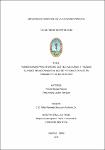| dc.contributor.advisor | Sologuren Anchante, Rafael Fernando | |
| dc.contributor.author | Hidalgo Palacios, Frescia | |
| dc.contributor.author | Lozano Rodríguez, Terry Antony | |
| dc.date.accessioned | 2017-01-31T16:08:53Z | |
| dc.date.available | 2017-01-31T16:08:53Z | |
| dc.date.issued | 2015 | |
| dc.identifier.uri | http://repositorio.unapiquitos.edu.pe/handle/20.500.12737/3749 | |
| dc.description.abstract | El presente estudio, tuvo como objetivo identificar las lesiones en los tejidos duros y tejidos blandos más frecuentes en pacientes portadores de piercings orales en la ciudad de Iquitos. El tipo de Investigación fue cuantitativo; su diseño fue no experimental, descriptivo simple. La muestra estuvo conformada por 45 personas. El instrumento utilizado fue la ficha de recolección de datos de pacientes portadores de piercings orales. Los resultados fueron: El uso de piercing oral es mayor en el sexo masculino con 57.8%. El tipo de piercing más usado fue el labrette con 46%, segundo del barbelle con 31,1% y anillo con 15,6% y los que usan los dos tipos a la vez 6,7%. El lugar de uso más frecuente fue el labio inferior con 62,2% seguido de la lengua con 26,7%, labio superior con 4,4% y frenillo 2,2%. El 62,2% presentaron recesión gingival, el 8,9% presentaron edema, el 40% presentaron inflamación en la zona de inserción y el 24% presentó ulcera. El 24,4% de los portadores presento abrasión en la pieza vecina a la zona de inserción y el 20% presento fractura de cúspides en las piezas vecinas. El 5,7 % presento dificultad para masticar, el 20% dificultad para la deglución y el 4,4% dificultad para el habla. El 24,4% presento acumulación de la placa bacteriana en la zona del piercing. El 93,3% de los portadores de piercing presento algún tipo de lesión. El 62,2% presento alguna dificultad. El 31,1% que presentó recesión gingival tuvieron un tiempo de uso de 1 a 2 años. El 6,9% que presentó edema tuvo un tiempo de uso menor de un año. El 24,4% que presentó inflamación tuvo un tiempo de uso menor de 1 año. El 13,3 % que presentó ulcera tuvo un tiempo de uso menor de 1 año. El 17,8% que presentó fractura tuvo tiempo de uso de 2 a más años. El 17,8% que presentó abrasión tienen un tiempo de uso menor de 2 años. Existe relación entre el tipo de piercing oral y su localización e inflamación. Existe relación entre la localización del piercing, la inflamación y fractura de las cúspides. Existe relación entre la recesión gingival e inflamación, entre edema e inflamación y entre inflamación y presencia de ulcera. Existe relación entre el tipo de piercing y su localización, entre el tipo de piercing y fractura de cúspides y entre la localización del piercing oral y fractura de las cúspides. | es_PE |
| dc.description.abstract | The present study aimed to identify the most common injuries in patients with oral piercings in the city of Iquitos hard tissue and soft tissue. The type of research was quantitative; its design was not experimental, descriptive simple. The sample consisted of 45 people. The instrument used was the record data collection of patients with oral piercings. The results were: The use of oral piercing is greater in males 57.8%. The type of piercing more labrette used was 46%, barbelle second with 31.1% and 15.6% ring and using the two types while 6.7%. Its most frequent use was lower lip with 62.2% followed by 26.7% tongue, upper lip frenulum 4.4% and 2.2%. 62.2% had gingival recession, 8.9% had edema, 40% had inflammation in the insertion and 24% had ulcer. 24.4% of carriers present in neighboring abrasion piece to the insertion and the 20% fracture present in at least one tooth cusps. 5.7% present difficulty chewing, 20% difficulty swallowing and 4.4% difficulty speaking. 24.4% showed accumulation of plaque in the area of the piercing. 93.3% of carriers of piercing introduce some kind of injury. 62.2% presented some difficulty. 31.1% presented gingival recession had a usage time 1-2 years. 6.9% I present edema had a time of less use than a year. 24.4% I present inflammation had a time of less use than 1 year. 13.3% I present ulcer had a time of less use than 1 year. 17.8% presented fracture had time to use 2 or more years. 17.8% presented abrasion have a shorter use of 2 years. There is a relationship between the type of oral piercing and location and inflammation. There is a relationship between the location of piercing, inflammation and fractured cusps. There relationship between gingival recession and inflammation, including edema and inflammation and between inflammation and presence of ulceration. There is a relationship between the type of piercing and its location, between the type of piercing and fractured cusps and between the location of oral piercing and fractured cusps. | en_US |
| dc.description.uri | Tesis | es_PE |
| dc.format | application/pdf | es_PE |
| dc.language.iso | spa | es_PE |
| dc.publisher | Universidad Nacional de la Amazonía Peruana | es_PE |
| dc.rights | info:eu-repo/semantics/openAccess | es_PE |
| dc.rights | Attribution-NonCommercial-NoDerivs 3.0 United States | * |
| dc.rights.uri | http://creativecommons.org/licenses/by-nc-nd/3.0/us/ | * |
| dc.source | Universidad Nacional de la Amazonía Peruana | es_PE |
| dc.source | Repositorio institucional - UNAP | es_PE |
| dc.subject | Lesiones | es_PE |
| dc.subject | Lengua | es_PE |
| dc.subject | Labio | es_PE |
| dc.title | Lesiones mas frecuentes en los tejidos duros y tejidos blandos relacionados al uso de piercings orales en pobladores de Iquitos 2014 | es_PE |
| dc.type | info:eu-repo/semantics/bachelorThesis | es_PE |
| thesis.degree.discipline | Odontología | es_PE |
| thesis.degree.grantor | Universidad Nacional de la Amazonía Peruana. Facultad de Odontología | es_PE |
| thesis.degree.level | Título Profesional | es_PE |
| thesis.degree.name | Cirujano Dentista | es_PE |
| thesis.degree.program | Regular | es_PE |
| dc.subject.ocde | http://purl.org/pe-repo/ocde/ford#3.02.14 | es_PE |


